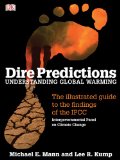While the 4th Assessment Report (4AR) of the Intergovernmental Panel on Climate Change (IPCC) represents the most comprehensive scientific assessment of the causes and consequences of climate change, the report itself is not written in language that is accessible to the average person. Written by climate scientists Michael Mann and Lee Kump, Dire Predictions is an accessible illustrated guide to the conclusions of the IPCC. It also includes some discussion of the practical, political, and ethical implications of the IPCC’s findings.
The 200 page book is a quick and easy read, even for those who are not well acquainted with scientific principles and terminology. It responds directly to many issues raised in the media (such as common climate change denier talking points) and it includes a great many illuminating charts and illustrations. It covers key concepts like what climate models are, and the reasons why we expect the planet to respond to a certain amount of additional carbon dioxide with a certain amount of warming.
The book is broken into five parts, covering climate change basics, projections, impacts, vulnerability and adaptation, and solutions. It very clearly describes which areas are well-understood scientifically and which areas contain substantial remaining uncertainties. Mann and Kump convincingly explain the core mutually-reinforcing lines of evidence that support the ‘big picture’ view of a world that is being dangerously warmed by human emissions, and in which greenhouse gas pollution must be reduced if major damage to humanity and the natural world is to be avoided.
The section on impacts is detailed and wide-ranging, covering everything from different projections of future sea level rise to expected impacts on global agriculture. It covers the trade-offs associated with different mitigation and adaptation strategies, and provides a brief overview of international efforts to address the problem. The section on solutions breaks down where humanity’s greenhouse gas footprint comes from, what options exist for reducing it, and what some of the economics of the situation are. Mann and Kump also do a good job of sketching some of the ethical issues associated with climate change, including the disjoint between the people producing emissions and the people likely to suffer most and the question of what represents a fair effort on the part of countries with different histories and present circumstances.
The book will be elementary to those who already have a through grounding in climate science and policy, though it may be a good way to get a quick and balanced overview of the whole subject. For those who are new to the topic or who feel confused about what the state of the scientific consensus is, this book would be an excellent place to begin.


One thought on “Dire Predictions: Understanding Global Warming”